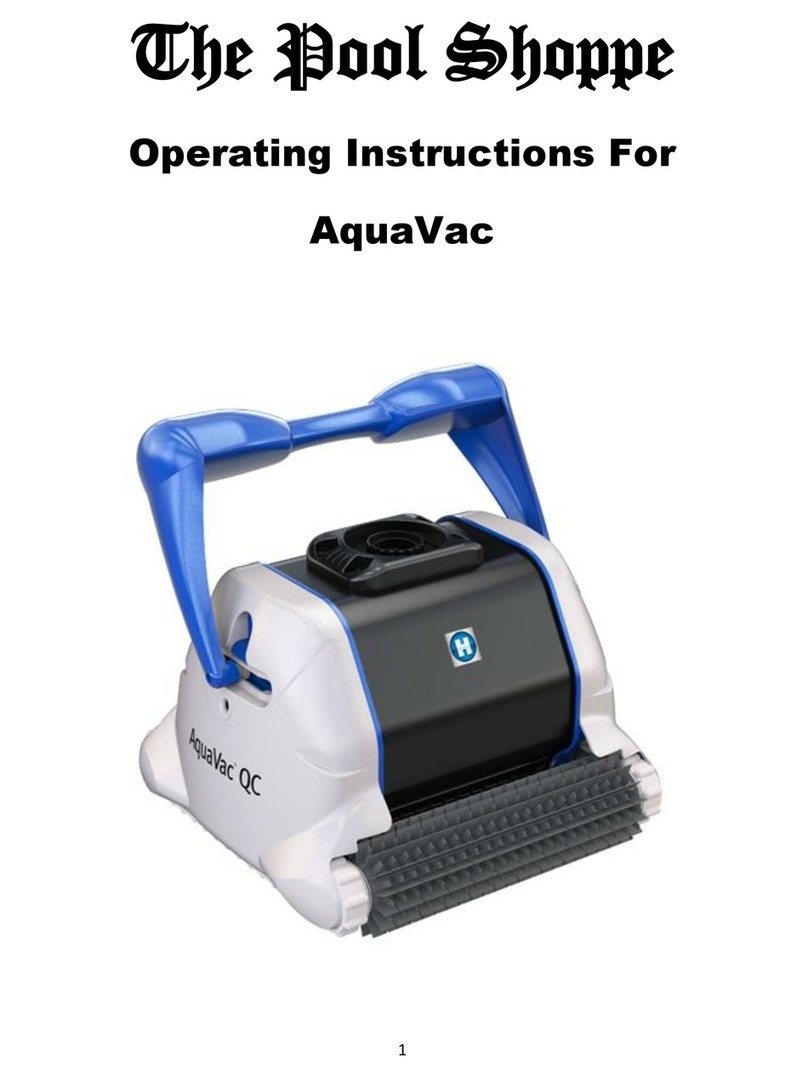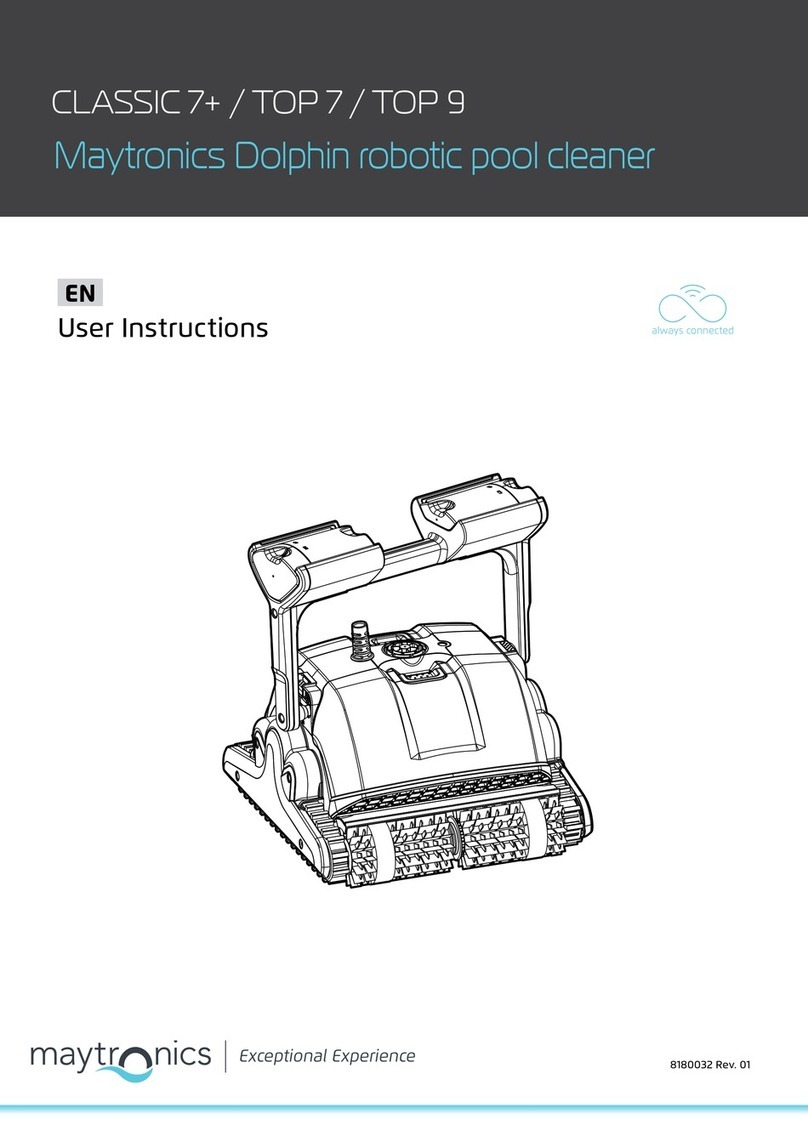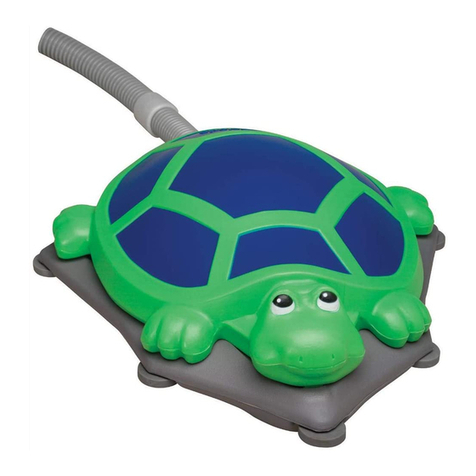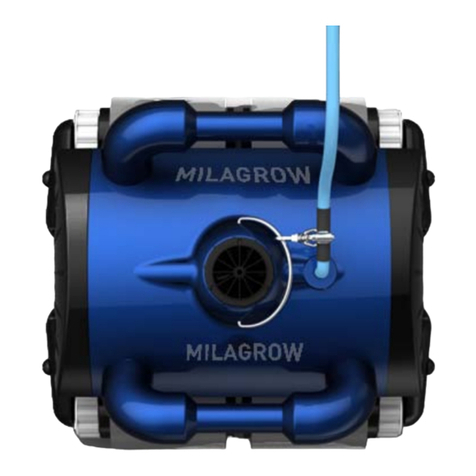Clear Water Zodiac LM2-24 User manual

LM Series
Professional Installation Manual
Owner’s Manual
& Warranty Information

Congratulations on your purchase of a Clearwater Chlorinator. You have made a wise decision and will
benefit from your Clearwater for many years to come. Please take a moment to read through the entire
manual before installing your new unit. Your chlorinator must be installed and operated as specified.
IMPORTANT SAFETY INSTRUCTIONS.
READ AND FOLLOW ALL INSTRUCTIONS.
SAVE ALL INSTRUCTIONS.
ELECTRICAL HAZARD
•To reduce risk of electrical shock
-Make sure all power to pool equipment area is off prior to any installation or removal of Clearwater
components.
-Replace damaged power pack cord immediately.
-Do not bury cord. Locate cord to minimize abuse from lawn mowers, hedge trimmers and other
equipment.
•Severe shock or injury will likely occur as a result of a drill or drill cord coming in contact with water.
Never allow electric drill or cord to come in contact with water. Only plug drill into a Class A (5
Milliampere Trip) protected Ground Fault Circuit Interrupter (GFCI) in accordance with the National
Electrical Code Section 680 (USA only). Please see your drill owner’s manual for further safety
precautions.
•Install the power pack at least 10 feet from the inside walls of a pool to prevent any possibility of the
unit coming in contact with water.
•Your Clearwater Chlorinator has been designed with an electronic flow switch. This device automatically
switches the chlorinator ‘OFF’ when the water through the cell stops.To prevent cell damage and
personal injury, do not in any way interfere with this system which has been designed for your
protection.
CHEMICAL USE HAZARD
•To avoid personal injury when working with pool chemicals, always wear rubber gloves and eye
protection and work in a well-ventilated area. Use caution when choosing a location to open and use
chemicals as they may damage any surface in which they come in contact.
•The addition of certain chemicals can reduce the effectiveness of chlorine. Always make sure that proper
residual chlorine levels are maintained to avoid personal injury.
•This product manufactures chlorine. Individuals with any type of chlorine sensitivity should take the
appropriate precautions to avoid injury or illness.
SAFETY INSTRUCTIONS
WARNING
Failure to heed the following warnings can result in
permanent injury, electrocution or drowning.
!
2

3
•Chlorinator must be installed and operated as specified.
•Scratching or bending plates in cell housing can reduce cell life.
•Power to the LM2 should be turned off before unplugging the cell connectors to prevent cell damage and
low voltage sparks.
•Keep the cell terminals protected with a light coating of silicone grease to allow for a positive electric
connection. Use of any other type of grease may damage the terminal seals and ‘o’ rings. Do not
immerse these terminals in acid wash solution, and avoid accidental contact with salt water.
•Water above the temperature of 104 degrees F (40 degrees C) flowing through the cell can cause plastic
cell to discolor.
•Power pack must not be installed directly above any other heat source such as filter, pump or heater. It
must be at least 1 Ft. (300 mm) from the ground to allow free circulation of air around it. It must not
be installed in a closed box. If the power pack is to be installed on a post, then it must be centrally
positioned on a flat panel of suitable waterproof material at least 10 inches (240mm) wide and 18 inches
(440mm) high.
•Check the cell frequently to prevent the accumulation of pool debris that for any reason may have by-
passed the pool filter.
CAUTION
Failure to heed the following warnings could cause
damage to pool equipment or personal injury.
!
SAFETY INSTRUCTIONS
EQUIPMENT WATER PRESSURE HAZARD
•Always turn pump off prior to installing or removing any Clearwater cell. Your pump/filter system is
operated under pressure and the pressure must be released before you begin work. Please see your
pump/filter owner’s manual for further instructions.
•To avoid cell damage, water pressure in the cell must not exceed 29 psi (200kPa)
PREVENT CHILD INJURY AND DROWNING
•To reduce the risk of injury, do not permit children to operate this product.
•Do not let anyone, especially small children, sit, step, lean, or climb on any equipment installed as part of
your pool’s operational system. Unless otherwise stated,ALL components of your pool's operational
system should be located at least 3 feet from the pool so children cannot use the equipment to gain
access and be injured or drown.

4
NOTES

5
Safety Instructions 2
Clearwater LM Series Product Specifications 6
Clearwater LM Installation (by qualified personnel only) 7
How Your Clearwater Chlorinator Works 10
Clearwater Model LM2 Operation 11
Control Panel Functions 12
Indicator Lights: What They Mean 14
Operating Tips 15
Salt: When And How To Add It 17
Salt Chart 18
Stabilizer Chart 19
Some Tips On Water Chemistry 20
Troubleshooting 22
Chlorinator Maintenance 27
Clearwater LM Series Limited Warranty 29
Clearwater LM Series Warranty Registration 31
Page No.
INDEX

6
CLEARWATER LM SERIES PRODUCT SPECIFICATIONS
Salt Level: 4000 ppm
Maximum chlorine output/hour
(gas chlorine equivalent)
LM2-24: 24 grams/hour
LM2-40: 40 grams/hour
DuoClear: 15 grams/hour
Minimum Flow rate: 12 gallons/minute
Plumbing: 1 1/2" or 2" Schedule 40 PVC
Maximum water temperature
through the cell: 104 F
Maximum operating pressure: 29 psi
Maximum salt level: 13,000 ppm
Power requirements: 220 volt
2 amp draw
Dimensions
Cell: 8 1/4" x 3" x 3 1/4"
Power pack: 7 5/8" x 14 3/4" x 4 7/8"
Limited warranty
Cell: 3 years
Power pack: 3 years
Clearwater LM Series chlorinators should be
installed on residential pools only.
Salt level in your Clearwater pool should never exceed 13,000 ppm

7
CLEARWATER LM INSTALLATION
Clearwater LM Installation
Clearwater saltwater chlorinators must be installed by a qualified swimming pool
professional or certified electrician. If you need assistance in finding a qualified installer
please contact our technical service department at 1-888-537-6657.
Installing the cell
The Clearwater cell MUST be installed horizontally, with the ports down, as the
last piece of pool equipment in line. (The design of the cell forms a natural gas trap. Even
though the LM unit has an internal flow sensor, this installation provides a secondary safety
feature to prevent gas build-up within the system.) There are no height restrictions or
requirements. The cell should be installed within 6’ of the power pack. Unions and adaptors
are provided. Water can flow in either direction without affecting performance. 11/2" or 2"
sch 40 rigid PVC is required. Any standard PVC cement may be used. Allow adequate drying
time before turning on the chlorinator.

8
Flooded Plumbing Installation
This occurs when the water level of the pool is above the height of the pool equipment. Some
pool systems may have valves that will isolate the equipment. If not, one ball valve should be
installed on the inlet side of the cell and a one-way check valve should be installed on the
outlet side of the cell.This will eliminate the possibility of having a gas build-up and possible
cell damage.
Multiple Installations
If conditions require multiple installations the LM series chlorinator may be plumbed in either
series or parallel providing that the header or manifold is balanced, providing equal flow to
each chlorinator.
Installing the Power Pack
The Power Pack can be mounted on a wall or a post. If mounting the Power Pack on a post, it
must be centered on a flat panel of waterproof material at least 9.5" x 17.5". Use the
template provided to position the anchors & mounting screws. Do not enclose the Power
Pack in any box. Do not install it above any heat source. Install the Power Pack a minimum of
3 feet from the pool edge. See your local building codes for requirements.
The Power Pack is hard-wired to 220V ONLY. It should be wired to the "LOAD" side of the
pump timer or the pump circuit of a controller, so that the Clearwater chlorinator comes on
only when the pump comes on. Connect the black & red output cables to either electrode on
the cell. Connect the blue sensor clip to the post.

9
Salt
Always test the salt level before adding salt. Refer to page 18 & 19 for instructions on
adding salt.
Safety Test
After installing the Clearwater chlorinator the following safety test MUST be performed.
Turn on the pool pump and the chlorinator. Adjust the chlorine output to maximum.
Disconnect the blue sensor clip from the terminal pin at the end of the cell. The RED "no
flow" light should be illuminated and the output lights should drop to the minimum, showing a
yellow light only. If this happens, the flow sensor is operating properly. Reconnect the blue
flow sensor clip to resume normal operation. Do not operate the unit if it fails this test.
Contact Zodiac at 1-888-537-6657 for instructions.

10
HOW YOUR CLEARWATER CHLORINATOR WORKS
How your Clearwater
Chlorinator Works
Common salt (sodium chloride) is made up of two elements, sodium and chloride.When your
Clearwater LM2 is installed, a measured quantity of salt is dissolved in the pool water to make
it slightly salty.As part of the daily filtration cycle, the pool water is passed through the
Clearwater electrolysis cell to produce chlorine which is dissolved instantly into the water.
Your Clearwater LM2 also produces ozone in the cell as a by-product.
In simple, non-technical terms, the chlorine instantly starts to destroy bacteria, viruses and
algae, and in doing this reverts to dissolved salt.This cycle continues with more new chlorine
being produced from the salt water in the electrolysis cell, sanitizing the pool, and changing
once more back to dissolved salt.
Everyday, when the Clearwater unit and the filtration system are switched on, dust and
debris are trapped by the filter and the Clearwater sanitizes the water to make if safe
and sparkling clean.
Important.
To ensure your LM2 works at maximum efficiency, regularly check and maintain the chemistry
of your pool.
Preferred Water Chemistry Readings
Salt concentration 4,000 ppm
pH 7.2 to 7.6
Chlorine stabilizer (Cyanuric acid) 40 to 100 ppm
depending on regional climate
Total alkalinity 80 to 120 ppm
Total hardness 200 to 400 ppm
Free chlorine 1 to 3 ppm

11
CLEARWATER MODEL LM2 OPERATION
Clearwater Model LM2
Operation
The chlorine production of the Clearwater LM2 is controlled by the number of hours the LM2
and filtration system is ON, as well as the setting of the output control. Power to this unit must
be controlled by the pump timer.The chlorinator functions may only be set when the filtration
system is running.
The Clearwater LM2 includes a Super Chlorinate feature which automatically super chlorinates
the pool for an approximated 24 hour period of pool pump operation.
The Clearwater LM2 is also fitted with 3 indicator lights that monitor the operation of the
chlorinator, the concentration of salt in the pool, and the water flow.
The LM2 is designed to require minimum operator maintenance using reverse polarity
technology to minimize the scaling of the cell.

CONTROL PANEL FUNCTIONS
Control Panel Functions
On / Off Button.
This button switches the LM2 ON and OFF. A yellow light appears in the chlorine output
indicator window when the unit is ON.
Output Button.
The output button is used to set the chlorine output of the LM2.
Chlorine output is selected by repeatedly pushing this button until maximum is reached on the
chlorine output indicator. An extra push of this button will reset the output to minimum.
Super Chlorinate Button.
The Super Chlorinate function is used to rapidly add chlorine to the pool.
This feature automatically super chlorinates your pool for approximately 24 hours of pool
pump run time.
Backup Battery.
The LM2 is fitted with a rechargeable battery. If the power is removed, the LM2 will retain the
output power settings and Super Chlorinate settings.
12

13
LM2 Display Panel
CONTROL PANEL FUNCTIONS

14
Indicator lights:
What they mean
Chlorine Output.
A series of six lights indicate the chlorine output setting of the power pack. More lights equals
greater chlorine production. Note: This setting does not show the actual chlorine reading in
the pool. Use of a test kit is required to confirm the Salt Level or Free Chlorine reading of the
pool water.
Chlorine Output - Yellow Light Flashing.
The yellow (low output) light flashes for a few minutes during cell reversal (cell self clean)
indicating no output during this time.
Super Chlorinate - Light ON.
This light indicates that the Super Chlorinate feature has been selected, it will turn OFF when
the Super Chlorinate period has ended.
Super Chlorinate - Light OFF.
Function not selected.
Add Salt - Light ON.
The Add Salt light will come on at any salt level between 3000ppm and 4000ppm depending on
mains voltage and water temperature (below 65˚).This is not a fault but a precaution to ensure
the salt level is never too low. (See ‘Salt:When And How To Add It’). Note: Operating the LM-2
at reduced salt levels may shorten the life of the cell.
Add Salt - Light OFF.
Indicates that the salt level in the pool is correct.
No Flow - Light ON.
This indicates insufficient water flow in cell, usually caused by the pump not running. The
chlorine output will also turn off at this time.
All Lights OFF.
All lights OFF indicates the LM2 is turned off.Turn unit ON. If lights are still OFF, check the
resettable fuse and circuit breaker.
INDICATOR LIGHTS – WHAT THEY MEAN

15
OPERATING TIPS
Operating Tips
A. Filtration and chlorination system operating periods.
Run your filtration and chlorination system for at least 6 to 8 hours per day.
During very hot weather it might be necessary to run the system for additional hours, but in
winter where pools remain open, it is only necessary to run the filtration system for around 4
hours per day. Shorter periods will help to lengthen the life of the cell electrodes.
B. Chlorine output settings.
Start operation of the Clearwater LM2 at maximum output. Add salt to the pool if the ‘Add
Salt’ light is showing. For a home pool of about 13,200 gallons, the addition of one (1) 50 lb.
bag of salt will increase the salt concentration by 500 ppm. Refer to ‘Salt:When And How To
Add It’ and the ‘Adding Salt Chart’ on pages 17-18.
C. Free (residual) chlorine reading.
The free chlorine residual in the pool should be between 1 - 3 ppm. Increasing the daily
operating period of the system increases the free chlorine reading, and a shorter operating
period reduces the chlorine reading. Likewise, operating the chlorinator at maximum output
will produce a higher chlorine reading than operating the chlorinator at a lower setting.
D. Chlorine stabilizer (Cyanuric acid) level.
The Chlorine stabilizer (cyanuric acid) reading should be between 40-100 ppm. This will vary
depending on your regional climate. Chlorine stabilizer helps to keep a satisfactory free
chlorine reading in hot sunny climates. Extremely hot and sunny climates will require readings
at the higher end of the given range. Refer to ‘Stabilizer Chart’ on page 19.
E. pH readings.
It is ABSOLUTELY ESSENTIAL that the pH of the pool be maintained in the range of 7.2 - 7.6.
The effectiveness of chlorine as a sanitizer is significantly reduced as the pH rises. At a pH of
8.0, nearly all of the chlorine being added to the pool is wasted, and it will be almost
impossible to maintain a satisfactory free chlorine reading.

16
F. Regular maintenance checks.
Weekly:
•Visually check the cell electrodes. Only if necessary, remove the cell and flush with a garden
hose to remove any debris that may have passed through the filter and lodged in the cell
housing.Avoid inserting objects into the cell which can scratch or bend the cell plates.
•Check the free chlorine.
•Check the total alkalinity. Adjust if necessary.
•Check the pH of the water. Adjust if necessary.
•Check the pressure gauge on the filter to see if backwashing is necessary.
Monthly:
•Check the salt concentration of the pool (see ‘Salt:When And How To Add It).
•Check the chlorine stabilizer reading.Adjust if necessary.
OPERATING TIPS

17
SALT:WHEN & HOW TO ADD IT
Salt:When And How To Add It
When to add salt.
Add salt when indicated on the control panel.The light marked ‘Add Salt’ functions
automatically when extra salt is needed. Note that the ‘Add Salt’ light may switch on at any salt
level between 3000 and 4000ppm, depending upon the water temperature and mains voltage
(see note).This is not a fault but a precaution to ensure that the salt level is never too low.
The salt concentration should normally be around 4000 ppm, but should never be allowed to
fall below 3000 ppm, as this can reduce the life of the cell electrodes.
Salt is not lost through evaporation. Salt is lost with the water splashed out of the pool or
during backwash. Adding fresh water or rainfall to the pool dilutes the salt concentration.
Adding salt may be needed from time to time to maintain an optimum salt level.
NOTE: Even if the salt concentration is around 4000 ppm, the ‘Add Salt’ light may switch ON
if the water temperature drops below 65˚ or mains supply voltage is too low. In this situation,
it may not be possible to set the Chlorine Output to maximum. Addition of more salt to the
pool will allow the Chlorine Output to reach maximum settings.
How much to add.
Use a salt test strip to determine salt level in pool water prior to adding any salt. Capture
water from elbows depth in a container, then use a test strip in this water sample. Previous
regular usage of sodium hypochlorite (liquid chlorine) creates residual salt within the pool and
may bring your salt level close to the required 4000 ppm concentration. Only 99.5% pure
refined salt (sodium chloride) should be used with the Clearwater chlorinator. Add enough
salt to obtain a 4000 ppm concentration.
- In a pool of approximately 13,200 gallons, one (1) 50 lb. bag of salt will increase the salt
concentration by 500 ppm.
- In a NEW pool (where there is no salt residual) of approximately 13,200 gallons, eight
(8) 50 lb bags of salt are required to reach a 4000 ppm concentration.
-Refer to ‘Salt Chart’ on page 18.
IMPORTANT:To avoid damage to your Clearwater chlorinator, never allow
salt level to exceed 13,000 ppm
How to add salt.
Evenly disperse the proper amount of salt around the perimeter of the pool. Run filter for 4-6
hours. Allow 24 hours for salt to fully dissolve. If the ADD SALT light is on after 24 hours, test salt
level and add necessary salt to obtain a 4000 ppm concentration. Even if the salt level is maintained
a 4000 ppm, but water temperature drops below 65˚, the ADD SALT may come on.This is not
cause for concern. For further assistance, consult your pool professional or call 1-888-537-6657.
Note: Do not add salt to the skimmer box.

18
Current Gallons and (Liters) of Pool/Spa Water
Salt
Level 12,000 14,000 16,000 18,000 20,000 22,000 24,000 26,000 28,000 30,000
ppm (45425) (52996) (60567) (68137) (75708) (83279) (90850) (98421) (105992) (113562)
0 401 467 534 601 668 734 801 868 935 1001
(182) (212) (242) (273) (303) (333) (363) (394) (424) (454)
250 376 438 501 563 626 688 75 814 876 939
(170) (199) (227) (256) (284) (312) (341) (369) (397) (426)
500 351 409 467 526 584 643 70 759 818 876
(159) (185) (212) (238) (265) (291) (318) (344) (371) (397)
750 325 380 434 488 542 597 651 705 759 814
(148) (172) (197) (221) (246) (271) (295) (320) (344) (369)
1000 300 351 401 451 501 551 601 651 701 751
(136) (159) (182) (204) (227) (250) (273) (295) (318) (341)
1250 275 321 367 413 459 505 551 597 643 688
(125) (146) (167) (187) (208) (229) (250) (271) (291) (312)
1500 250 292 334 376 417 459 501 542 584 626
(114) (132) (151) (170) (189) (208) (227) (246) (265) (284)
1750 225 263 300 338 376 413 451 488 526 563
(102) (119) (136) (153) (170) (187) (204) (221) (238) (256)
2000 200 234 267 300 334 367 401 434 467 501
(91) (106) (121) (136) (151) (167) (182) (197) (212) (227)
2250 175 204 234 263 292 321 351 380 409 438
(79) (93) (106) (119) (132) (146) (159) (172) (185) (199)
2500 150 175 200 225 250 275 300 325 351 376
(68) (79) (91) (102) (114) (125) (136) (148) (159) (170)
2750 125 146 167 188 209 229 250 271 292 313
(57) (66) (76) (85) (95) (104) (114) (123) (132) (142)
3000 100 117 134 150 167 184 200 217 234 250
(45) (53) (61) (68) (76) (83) (91) (98) (106) (114)
3250 75 88 100 113 125 138 150 163 175 188
(34) (40) (45) (51) (57) (62) (68) (74) (79) (85)
3500 50 58 67 75 83 92 100 108 117 125
(23) (26) (30) (34) (38) (42) (45) (49) (53) (57)
3750 25 29 33 38 42 46 50 54 58 63
(11) (13) (15) (17) (19) (21) (23) (25) (26) (28)
4000 Optimum Optimum Optimum Optimum Optimum Optimum Optimum Optimum Optimum Optimum
Adding Salt to Your Pool
Pounds and (KG) of salt needed to raise level to 4000 PPM
SALT CHART

19
Adding Stabilizer to Your Pool
Pounds and (KG) of stabilizer (Cyanuric Acid)
needed to raise level to 80 PPM
Current Gallons and (Liters) of Pool/Spa Water
Chlorine
Stabilizer
Level 12,000 14,000 16,000 18,000 20,000 22,000 24,000 26,000 28,000 30,000
ppm (45425) (52996) (60567) (68137) (75708) (83279) (90850) (98421) (105992) (113562)
08.0 9.3 10.7 12.0 13.4 14.7 16.0 17.4 18.7 20.0
(3.6) (4.2) (4.8) (5.5) (6.1) (6.7) (7.3) (7.9) (8.5) (9.1)
10 7.0 8.2 9.3 10.5 11.7 12.9 14.0 15.2 16.4 17.5
(3.2) (3.7) (4.2) (4.8) (5.3) (5.8) (6.4) (6.9) (7.4) (7.9)
20 6.0 7.0 8.0 9.0 10.0 11.0 12.0 13.0 14.0 15.0
(2.7) (3.2) (3.6) (4.1) (4.5) (5.0) (5.5) (5.9) (6.4) (6.8)
30 5.0 5.8 6.7 7.5 8.3 9.2 10.0 10.8 11.7 12.5
(2.3) (2.6) (3.0) (3.4) (3.8) (4.2) (4.5) (4.9) (5.3) (5.7)
40 4.0 4.7 5.3 6.0 6.7 7.3 8.0 8.7 9.3 10.0
(1.8) (2.1) (2.4) (2.7) (3.0) (3.3) (3.6) (3.9) (4.2) (4.5)
50 3.0 3.5 4.0 4.5 5.0 5.5 6.0 6.5 7.0 7.5
(1.4) (1.6 ) (1.8) (2.0) (2.3) (2.5) (2.7) (3.0) (3.2) (3.4)
60 2.0 2.3 2.7 3.0 3.3 3.7 4.0 4.3 4.7 5.0
(0.91) (1.1) (1.2) (1.4) (1.5) (1.7) (1.8) (2.0) (2.1) (2.3)
70 1.0 1.2 1.3 1.5 1.7 1.8 2.0 2.2 2.3 2.5
(0.45) (0.53) (0.61) (0.68) (0.76) (0.83) (0.91) (1.0) (1.1) (1.1)
80 Optimum Optimum Optimum Optimum Optimum Optimum Optimum Optimum Optimum Optimum
The above chart is for general reference only.The recommended stabilizer reading is
between 40-100 ppm and will vary dependent on geographic climate.Warm, sunny
climates will require a stabilizer reading at the higher end of the given range. Consult
your local pool professional for your optimum level.Always add stabilizer according to
manufacturer’s instructions.
STABILIZER CHART

20
SOME TIPS ON WATER CHEMISTRY
Some Tips On
Water Chemistry
How to adjust pH.
A pH range of 7.2 - 7.6 is ideal for maximum comfort and minimum chlorine demand. Always
adjust total alkalinity before adjusting pH.
Low pH (acidic water) leads to stinging eyes and corrosion of open metal fittings. Raise the pH
by adding sodium bicarbonate or soda ash. Consult your pool professional regarding which
chemical is best for your situation and the proper amount to use. Check the pH after 4 hours
of circulation, adjusting as necessary to achieve the proper range.
High pH (alkaline water) leads to clouding of the water and reduces the amount of active
chlorine.This means algae and germs can grow. Lower the pH by adding muriatic acid to the pool
water.The acid demand indicated by your 4-in-1 test kit will show the amount of acid to use.
If your pH remains inconsistent, check your total alkalinity.
Total alkalinity affects pH.
To tal alkalinity is a measure of the alkaline chemicals in your pool water (eg. Bicarbonates,
carbonates, and hydroxides). It can be thought of as the buffering system necessary to control
pH. Low alkalinity can be compared to weak shock absorbers on a car, allowing pH to
fluctuate.The pH will be difficult to maintain and staining of pool surfaces may occur when
total alkalinity is too low.
Total alkalinity should be in the range of 80 - 120 ppm.Total alkalinity is often confused with
pH, which it affects.
To raise total alkalinity, add pH buffer (sodium bicarbonate) at the rate shown in the
manufacturers instructions to achieve a reading in the 80 - 120ppm range. 1.5 lbs. of sodium
bicarbonate raises 10,000 gallons of pool water by 10 ppm.
To lower the total alkalinity, use muriatic acid.The acid demand chart in your 4-in-1 test kit will
indicate the necessary amount to add.Adjust as needed until the reading (taken at least 24
hours later) is in the 80-120 ppm range.When total alkalinity is correct, you may need to
adjust pH.
This manual suits for next models
1
Table of contents
Popular Swimming Pool Vacuum manuals by other brands

Kokido
Kokido EV40 user manual
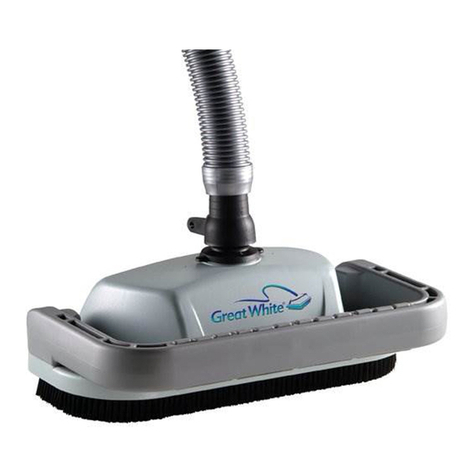
Pentair Pool Products
Pentair Pool Products GreatWhite Automatic Pool Cleaner Installation and user guide
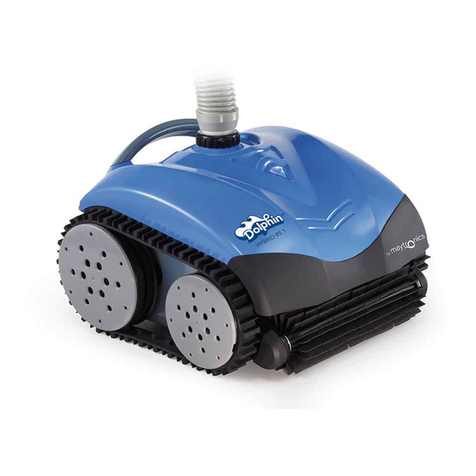
Dolphin
Dolphin Hybrid RS1 operating instructions
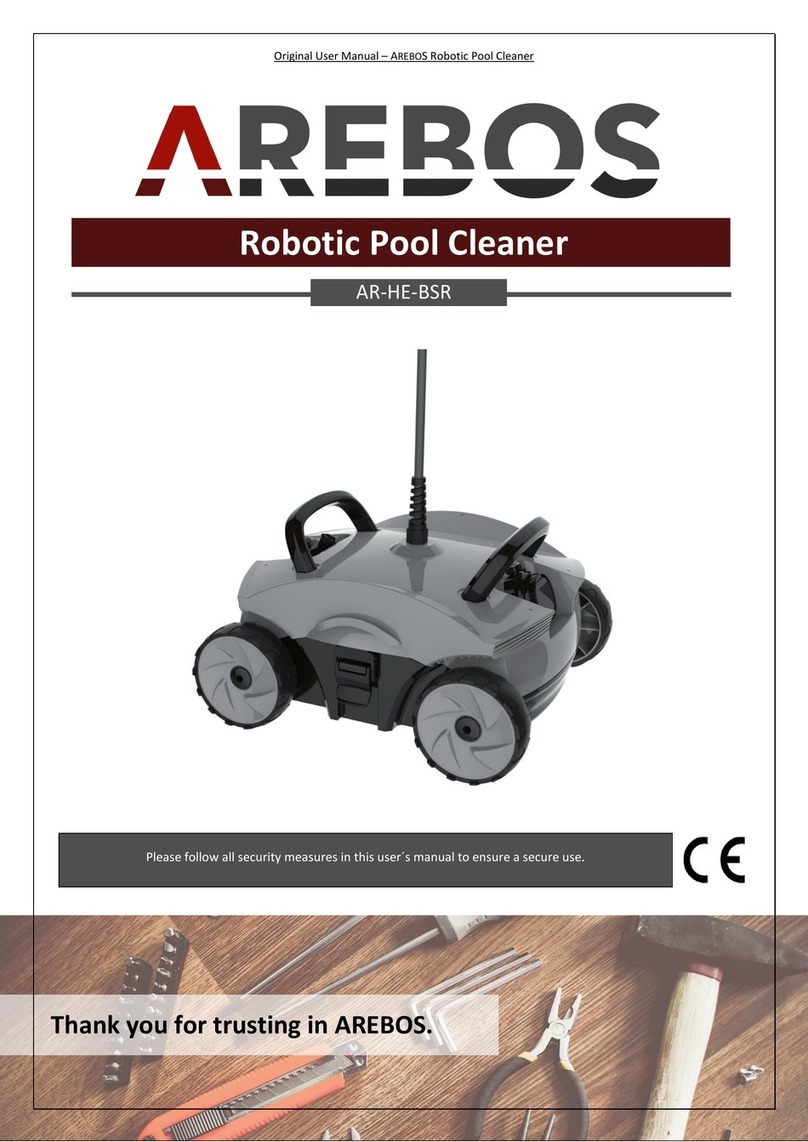
AREBOS
AREBOS AR-HE-BSR Original user manual
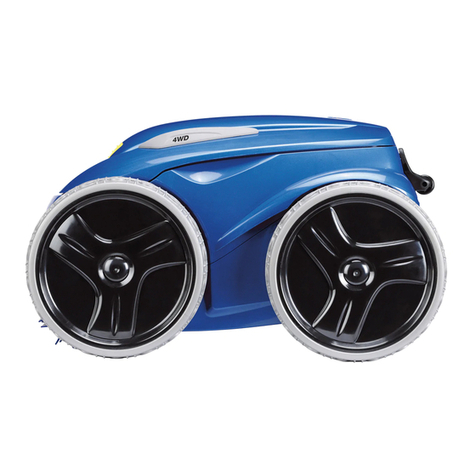
Zodiac
Zodiac RV 5480 iQ Instructions for installation and use

Winny
Winny OPTIMUS PRO HJ3052 user manual
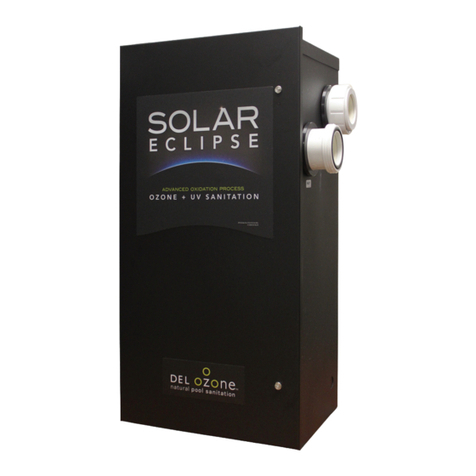
Del ozone
Del ozone Solar Eclipse Installation & operation manual
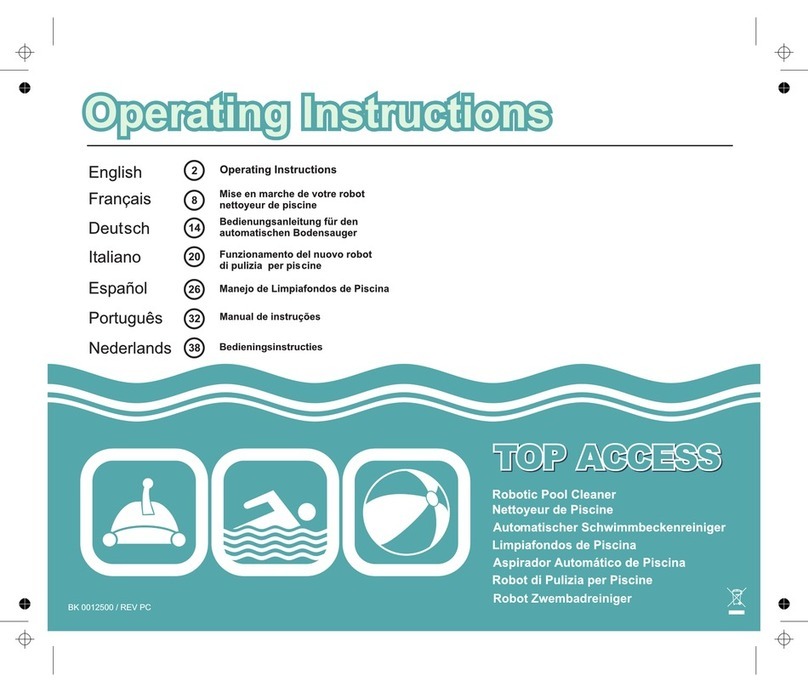
Aquabot
Aquabot Robotic Pool Cleaner operating instructions
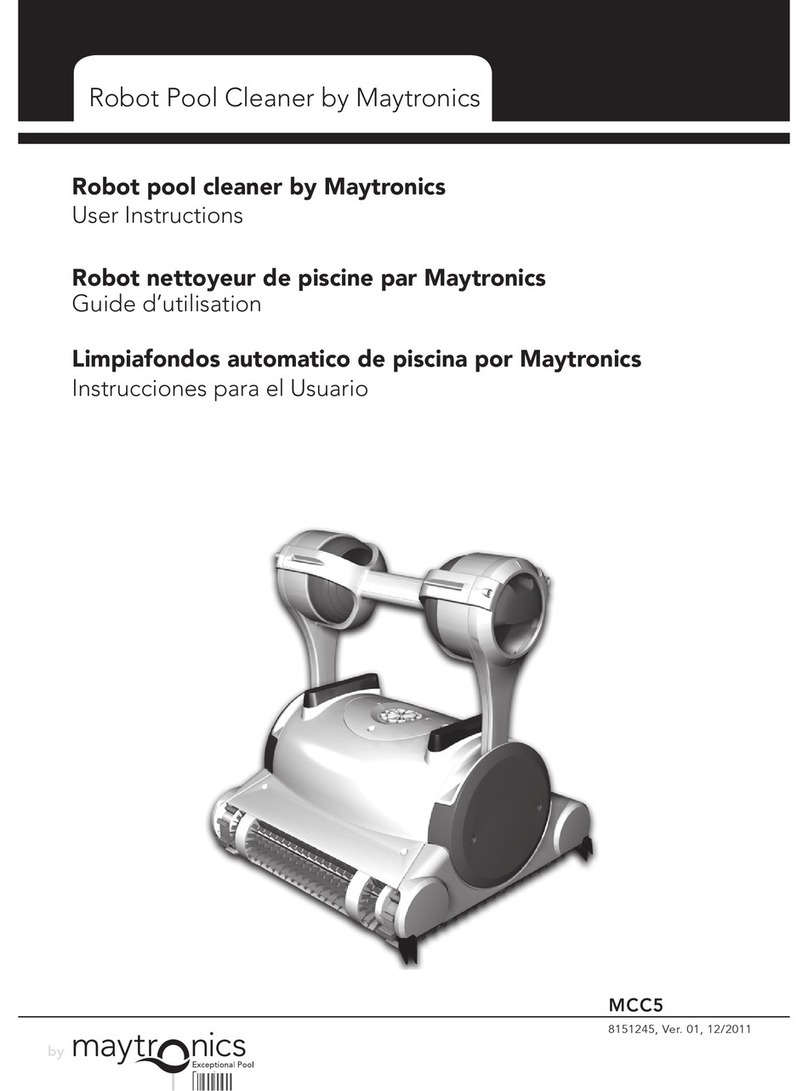
Maytronics
Maytronics MCC5 User instructions

Aquabot
Aquabot Pura 4X quick start guide
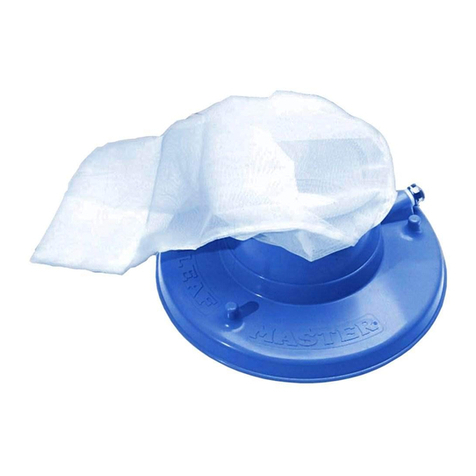
Jandy Pro Series
Jandy Pro Series Leaf Master 1142 Assembly instructions
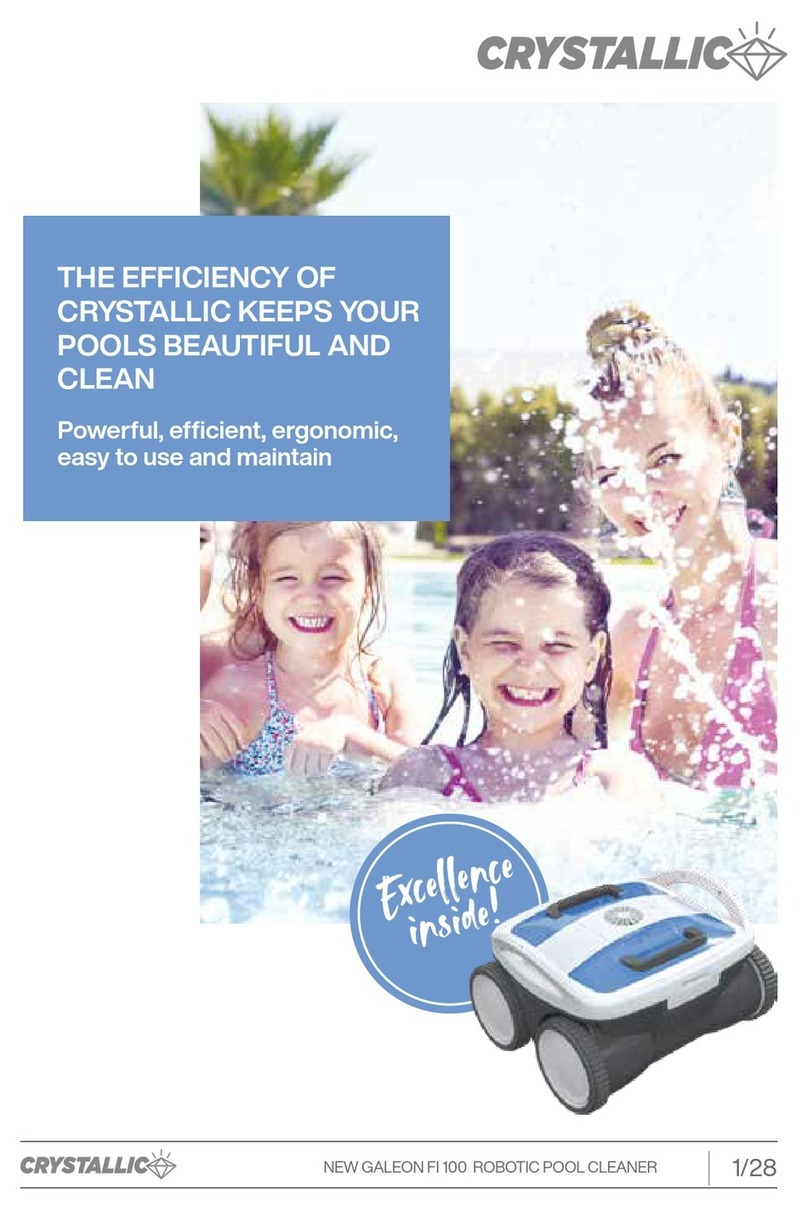
CRYSTALLIC
CRYSTALLIC NEW GALEON FI 100 quick start guide
